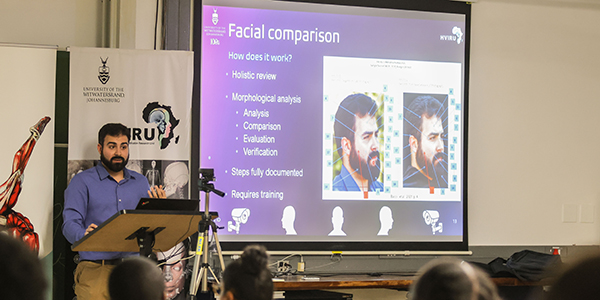Smarter human oversight is crucial in facial recognition AI
- Wits University
Enhanced human verification techniques and practices will always be required to ensure accuracy and ward off inherent biases.

Machines have their place in the world and AI is rapidly changing the definition of modern living, but humans equipped with better skills may still have the edge on doing some things better.
For Dr Nicholas Bacci, one of those things is in forensic facial comparison. Bacci is a lecturer in the School of Anatomical Sciences and comes from a background in forensic anthropology. His area of study is an emerging field and focuses on improving techniques of manual facial comparison especially for applications in the medical and legal fields.
Enhancing techniques and validating methods
His PhD, which he completed in 2021, involved collecting a large database of over 700 facial images including stills, standardised and non-standardised images and CCTV image and running these through a series of validation studies to create comparison and validation techniques and checklists.
“We also combined this with the gold standard of facial comparison that of morphological analysis. This is an anatomical process of looking at each feature of the face in thorough detail and trying to ascertain whether the person would be a match or another face,” he said.
He said the techniques he’s working on developing can be taught to train the likes of police officers, those who work in security and crowd control, forensic anthropologists and auditors and down the line, virtually anybody who works with large groups of people or faces – including hospital workers and even lecturers and teachers.
The importance of human expertise
Bacci presented a lecture at the beginning of June at Wits outlining his work and the future plans for his research. He argued the importance, in a world heavily reliant on artificial intelligence, to insert trained people back into the process of facial identification and comparison. This is especially relevant, he said, in the medical and legal fields. For Bacci, human beings with adequate training working and within a framework of independent peer oversight can bring a level of critical judgement and considered analysis for successful facial comparison. As such it still trumps the rigid automation of algorithms and recognition software.
Addressing bias and limitations
One of the major drawbacks of current facial recognition software lies in its inherent biases, mirroring the societal divides and inequalities prevalent in the world.
Bacci, in his lecture, set out the evolution of facial identification. The development of photography meant photographic imagery could use faces – the still enduring standard of the “mug shot” - as a record for identification. The technology has advanced to facial recognition and identification being driven by AI with ever smarter software. It’s now widely used in everything, from banking to cyber security, passport control and public surveillance.
But there are limits to AI and the current-day facial recognition software, Bacci says. These limits come in part because they mirror the massive divides and inequalities in the world. It means these systems and software have built-in bias and can turn up more false positives or cannot reliability adjust for nuances and contexts when they are not applicable to experiences related to the developed world.
“With those systems being developed in western locations and by people in those populations it means for instance that any person of colour tends to be misidentified more easily because the algorithms are simply not trained as extensively,” he said.
The role of human verification
Bacci said there cautions should come from the numerous examples of AI and automated facial recognition software resulting in people being wrongfully accused of crimes and convicted. This comes with severe consequences for upholding justice and the ability to create public trust in the capabilities of law enforcement and the fairness of the judicial process.
“The presumption of innocence under proven guilty is a core tenant of the countries that go by the Geneva Convention. Hence we would rather err on the side of a false negative than on a false positive so we don’t end up incarcerating someone who’s actually not responsible for a specific criminal activity,” he said, adding that the role of manual or human-led facial comparison can become a kind safety net that's vital in a democratic society.
“AI cannot be a complete replacement for human expertise. There should be a person at some point in the operational loop of the system so that they can still analyse, compare, evaluate and verify. AI should strictly be an enhancement adding to the efficiency and helping to make processes quicker for us. Human verification should always still be required in the process of facial identification,” Bacci added.
Empowering professionals and ensuring accuracy
Bacci and his colleagues at Wits have for some years already been working to use manual facial comparison techniques to enhance the skills of police officers in South Africa. Because of rising demand and growing applications for these skills – especially when they can stand up in a court of law - Bacci and his colleagues are developing an accredited short course in forensic facial comparison that will be launched in 2024.
The training will delve into aspects of anatomical training; basic image analysis training, improving photographic capture for better analysis and deepening the understanding of how these overall processes are practically used through hands-on training.

